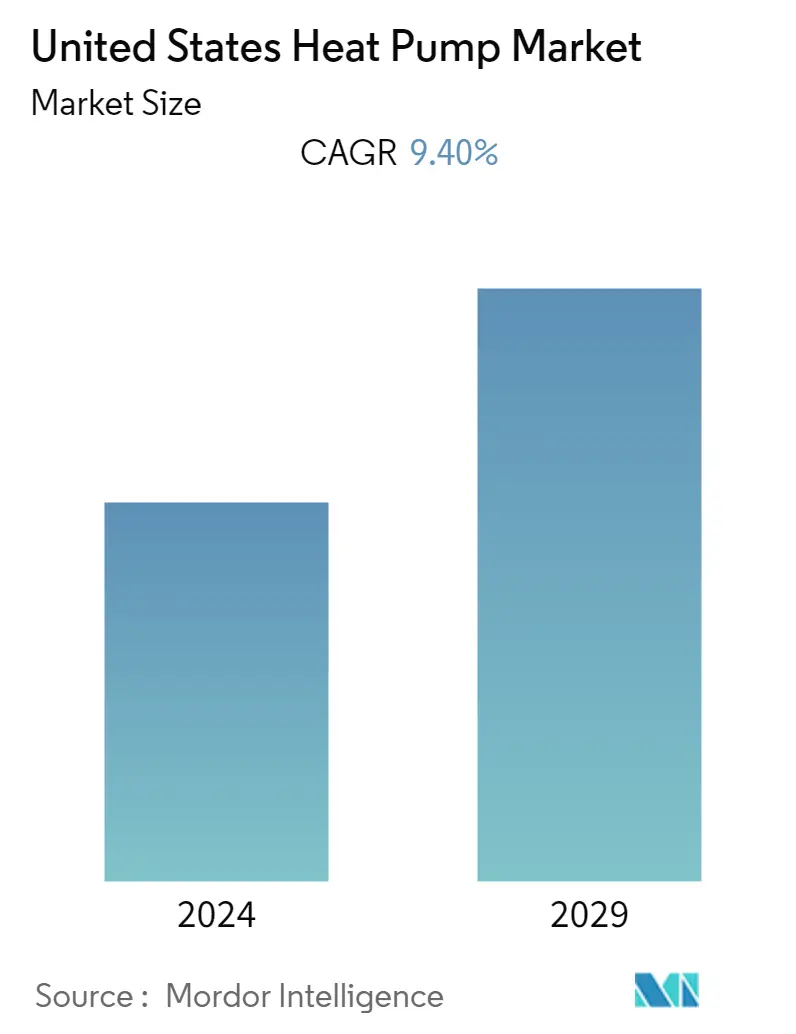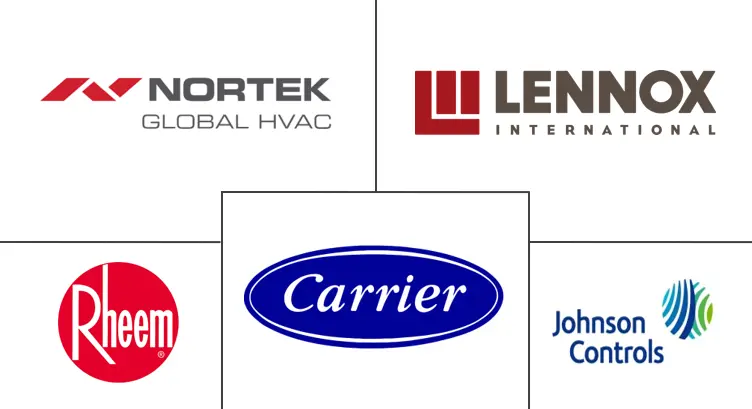Market Size of United States Heat Pump Industry

| Study Period | 2019 - 2029 |
| Base Year For Estimation | 2023 |
| Forecast Data Period | 2024 - 2029 |
| Historical Data Period | 2019 - 2022 |
| CAGR | 9.40 % |
| Market Concentration | Medium |
Major Players
*Disclaimer: Major Players sorted in no particular order |
US Heat Pump Market Analysis
United States Heat Pump Market is expected to be USD 9.87 billion in 2021 registering a CAGR of 9.4% over the forecast period (2022 - 2027). The COVID-19 pandemic outbreak has created an economic turmoil for small, medium, and large-scale industries alike, in the United States. While it is realistic to expect a slow growth in sales of heat pumps sales, government policies and consumer demand are expected to drive the sales of heat pumps. End users are now increasingly concerned of disruptions and dangers threatened by climate change and carbon emissions (informally known as 'the Blue Planet Effect') and are making environmentally-responsible heating choices.
- The introduction of new government regulations, in the United States, is expected to result in increased energy efficiency of HVAC equipment. Starting from 2023, all new residential central air-source heat pump systems sold in the United States are expected to meet new minimum energy efficiency regulations and standards. The latest minimum energy efficiency standards for these equipment types went into effect in 2015. The new regulations require an increase in the heating efficiency of all air-source heat pumps.
- Moreover, the US Environmental Protection Agency (EPA) reported that homeowners could save up to 70% on heating costs and 50% on cooling costs with geothermal. Such instances are likely to boost the market growth.
- According to the International Energy Agency (IEA), these pumps are less common worldwide, as they have an annual sales of around 400,000, in which more than half of the installations are in the United States, where shipments and installations have more than doubled since 2010, partly owing to a 30% federal tax credit available during 2018-21.
- Furthermore, the heat pumps have been regulated by the governments in the region for their energy efficiency. For instance, the Department of Energy (DOE) announced Fan Energy Rating (FER) that sets a minimum airflow efficiency standard for residential furnace fans.
- With the new FER standards, the US DOE predicts that the new standard for furnace fans might save about 3.99 quads of energy, reduce carbon pollution by 34 million metric tons, and save the American citizens more than USD 9 billion electric bills through 2030. According to new state law, the city of Maine seeks installers to help meet the goal of 100,000 heat pumps over the next five years.
US Heat Pump Industry Segmentation
Heat Pumps are equipments that are alternatives to air conditioners and furnaces in all climates. The equipment uses electricity to transfer the heat from a cool space to warm space. Scope of the report covers a detailed analysis on diffrent types of heat pumps use across various end users in the cpountry.
The study includes various heat pumps, such as air source, water source, and geothermal sources, across various end-user industries, such as industrial, commercial, and residential, among others. The competitive landscape has been taken to calculate the heat pump penetration and how players involve themselves in organic and inorganic growth strategies. Additionally, these companies continuously innovate their products to increase their market share and profitability. Furthermore, the market study has also focused on the impact of the COVID-19 pandemic on the market ecosystem. Also, the recent changes in the trade scenario are analyzed in the study.
| By Type | |
| Air-source | |
| Water-source | |
| Geothermal (ground) Source |
| By End User | |
| Residential | |
| Commercial | |
| Industrial |
United States Heat Pump Market Size Summary
The US heat pump market is poised for significant growth, driven by increasing consumer demand for energy-efficient and environmentally friendly heating solutions. The market is experiencing a shift as end users become more aware of the impacts of climate change and carbon emissions, prompting a move towards sustainable heating options. Government regulations are playing a crucial role in this transition, with new energy efficiency standards for HVAC equipment set to take effect, enhancing the performance of air-source heat pumps. These regulatory changes, coupled with incentives like federal tax credits, have contributed to a surge in heat pump installations, particularly in regions previously resistant to such technologies due to colder climates. The market is further bolstered by advancements in heat pump technology, making them viable alternatives even in subfreezing temperatures.
The competitive landscape of the US heat pump market is characterized by the presence of major players such as Lennox, Daikin, and Carrier, who are leveraging innovation and strategic partnerships to expand their market presence. The introduction of new products, such as the CO2 heat pump water heater by Mitsubishi Electric Trane HVAC US, underscores the industry's focus on decarbonization and the replacement of fossil fuel-based systems. Additionally, the market is witnessing a gradual increase in residential absorption heat pumps, which utilize diverse heat sources for heating. The ongoing growth in residential construction further presents opportunities for heat pump vendors, as more homes seek to incorporate these efficient systems. Overall, the US heat pump market is set to experience robust expansion, driven by regulatory support, technological advancements, and a growing emphasis on sustainability.
United States Heat Pump Market Size - Table of Contents
-
1. MARKET INSIGHTS
-
1.1 Market Overview
-
1.2 Industry Attractiveness - Porter's Five Forces Analysis
-
1.2.1 Bargaining Power of Suppliers
-
1.2.2 Bargaining Power of Consumers
-
1.2.3 Threat of New Entrants
-
1.2.4 Intensity of Competitive Rivalry
-
1.2.5 Threat of Substitutes
-
-
1.3 Assessment of the Impact of COVID-19 on the Industry
-
1.4 Industry Value Chain
-
1.5 Thecnology Snapshot on Efficiency (only for relevant equipment which are regulated by Federal Standards)
-
1.5.1 Low (HSPF: 8.0-8.99)
-
1.5.2 High (HSPF: 9 and Above)
-
-
-
2. MARKET SEGMENTATION
-
2.1 By Type
-
2.1.1 Air-source
-
2.1.2 Water-source
-
2.1.3 Geothermal (ground) Source
-
-
2.2 By End User
-
2.2.1 Residential
-
2.2.2 Commercial
-
2.2.3 Industrial
-
-
United States Heat Pump Market Size FAQs
What is the current United States Heat Pump Market size?
The United States Heat Pump Market is projected to register a CAGR of 9.40% during the forecast period (2024-2029)
Who are the key players in United States Heat Pump Market?
Lennox International Inc., Nortek Air Management, Carrier Corporation, Rheem Manufacturing Company and Johnson Controls International PLC are the major companies operating in the United States Heat Pump Market.

